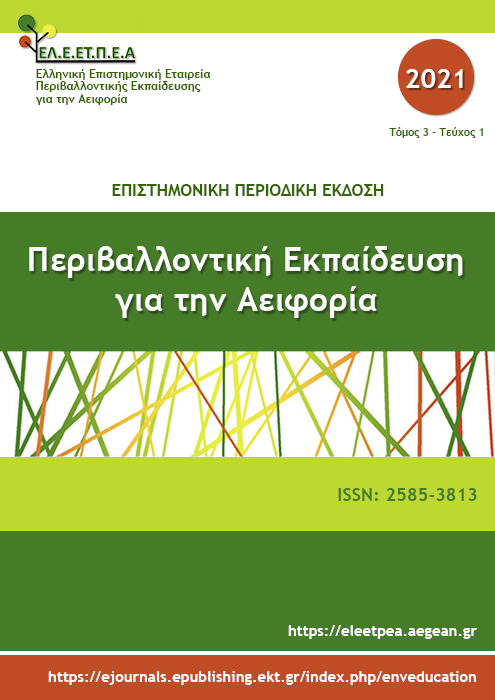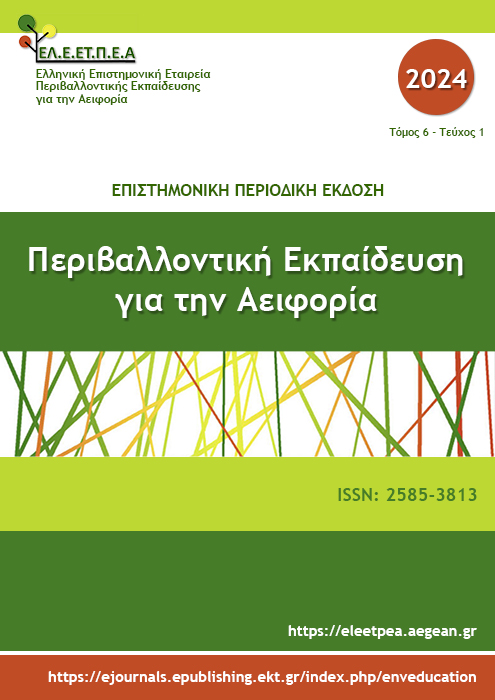Η περιβαλλοντική εκπαίδευση ως πλαίσιο αντιμετώπισης του φαινομένου «Τυφλότητα Απέναντι στα Φυτά»
Resumen
Σημαντικός αριθμός μελετών τα τελευταία χρόνια επιβεβαιώνει το μειωμένο ενδιαφέρον των ανθρώπων για τους φυτικούς οργανισμούς. Το φαινόμενο αυτό ονομάζεται τυφλότητα απέναντι στα φυτά (Plant Blindness) και μεταξύ άλλων περιλαμβάνει την παράβλεψη των φυτών μέσα στον περιβάλλοντα χώρο και την έλλειψη αναγνώρισης των λειτουργικών τους ρόλων στο οικοσύστημα. Σκοπός της παρούσας έρευνας είναι να προσδιοριστεί η επίδραση της περιβαλλοντικής εκπαίδευσης, όπως αυτή προσφέρεται μέσω προγραμμάτων σχολικών δραστηριοτήτων και ακαδημαϊκών μαθημάτων στις τρεις βαθμίδες ελληνικής εκπαίδευσης, στη μείωση της έντασης του φαινομένου. Συνολικά 1237 μαθητές πρωτοβάθμιας, δευτεροβάθμιας και φοιτητές τριτοβάθμιας εκπαίδευσης συμμετείχαν στην έρευνα συμπληρώνοντας ερωτηματολόγιο. Σύμφωνα με τα αποτελέσματα, η περιβαλλοντική εκπαίδευση φαίνεται να συμβάλει στον περιορισμό της τυφλότητας απέναντι στα φυτά καθώς επιδρά στο σύνολο των παραμέτρων που προσδιορίζουν το φαινόμενο. Το συγκεκριμένο εύρημα αναδεικνύει εκ νέου την περιβαλλοντική εκπαίδευση ως πολύτιμο διδακτικό πλαίσιο και φέρνει στο προσκήνιο τη δυνατότητα περαιτέρω εμπλουτισμού της με σύγχρονες εκπαιδευτικές προσεγγίσεις όπως η «βασισμένη στον τόπο εκπαίδευση» και οι «βιώσιμα προσανατολισμένες οικολογίες μάθησης».
Article Details
- Cómo citar
-
Αμπράζης Α., & Παπαδοπούλου Π. (2021). Η περιβαλλοντική εκπαίδευση ως πλαίσιο αντιμετώπισης του φαινομένου «Τυφλότητα Απέναντι στα Φυτά». Περιβαλλοντική Εκπαίδευση για την Αειφορία, 3(1), 38–54. https://doi.org/10.12681/ees.26284
- Sección
- Articles

Esta obra está bajo una licencia internacional Creative Commons Atribución-NoComercial-CompartirIgual 4.0.
Οι συγγραφείς διατηρούν τα πνευματικά δικαιώματα και παρέχουν στο περιοδικό το δικαίωμα της πρώτης δημοσίευσης μαζί με την αδειοδότηση της εργασίας με CC-BY-NC-SA, που επιτρέπει σε άλλους να μοιράζονται αυτή την εργασία με αναγνώριση του συγγραφικού δικαιώματος και την αρχική δημοσίευση σε αυτό το περιοδικό.




